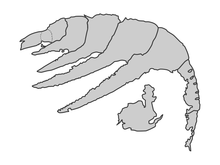Peytoia infercambriensis
| Peytoia infercambriensis Temporal range:
| |
|---|---|

| |
| Interpretive drawing of holotype specimen of P. infercambriensis | |
| Scientific classification | |
| Domain: | Eukaryota |
| Kingdom: | Animalia |
| Phylum: | Arthropoda |
| Class: | †Dinocaridida |
| Order: | †Radiodonta |
| Family: | †Hurdiidae |
| Genus: | †Peytoia |
| Species: | †P. infercambriensis
|
| Binomial name | |
| †Peytoia infercambriensis (Lendzion, 1975)
| |
| Synonyms | |
| |
Peytoia infercambriensis is a species of
P. infercambriensis is the geologically oldest known radiodont; its remains date to the
History of study
Discovery and naming
The holotype—and only—specimen was recovered from the
Reinterpretations
In 1988, Jerzy Dzik and Kazimiera Lendzion reinterpreted the specimen as representing the appendage of an
These diverse interpretations led Alison Daley and David Legg to restudy the original specimen. They concluded that the specimen did indeed consist of both a body and appendage, but that they did not belong to the same animal. Rather, the body was that of an indeterminate arthropod, while the appendage was that of a radiodont similar to Peytoia nathorsti. As such, they synonymized Cassubia with Peytoia, making the new combination Peytoia infercambriensis.[8]
Description
Peytoia infercambriensis differed from its close relative Peytoia nathorsti in several characteristics of its frontal appendage, the only part of its anatomy known. The ventral spines are only half as wide as the associated podomere, and are estimated to have borne approximately 24 tightly-spaced auxiliary spines. The endites decrease sharply in length, such that the distalmost endite is only a quarter the length of the proximalmost.[8]
Paleoecology
The Zawiszyn Formation, in which the only known specimen of Peytoia infercambriensis was found, dates back to the
References
- ^ a b Lendzion, Kazimiera (1975). "Fauna of the Mobergella zone in the Polish Lower Cambrian". 19 (2): 237–242.
{{cite journal}}: Cite journal requires|journal=(help) - ^ Lendzion, Kazimiera (1977). "Cassubia - a new generic name for Pomerania Lendzion, 1975". Geological Quarterly. 21 (1).
- ^ .
- ^ S2CID 130070181.
- ISSN 1189-9905.
- S2CID 130637114.
- S2CID 82841481.
- ^ S2CID 130745134.
